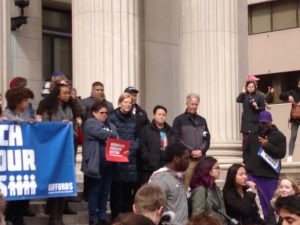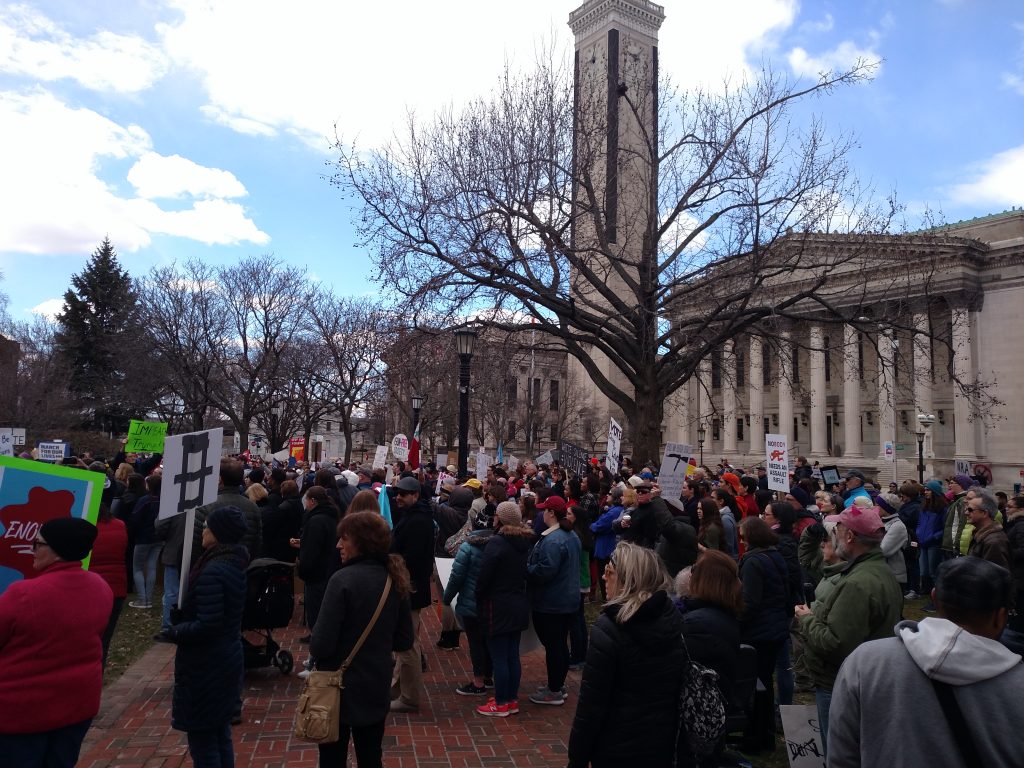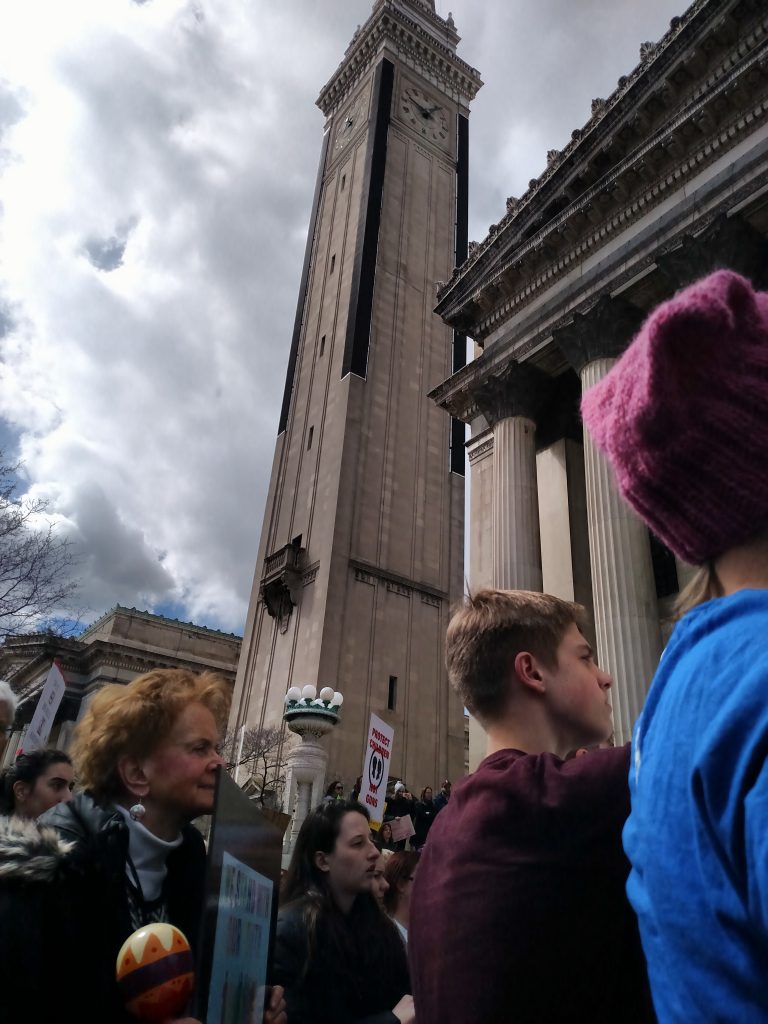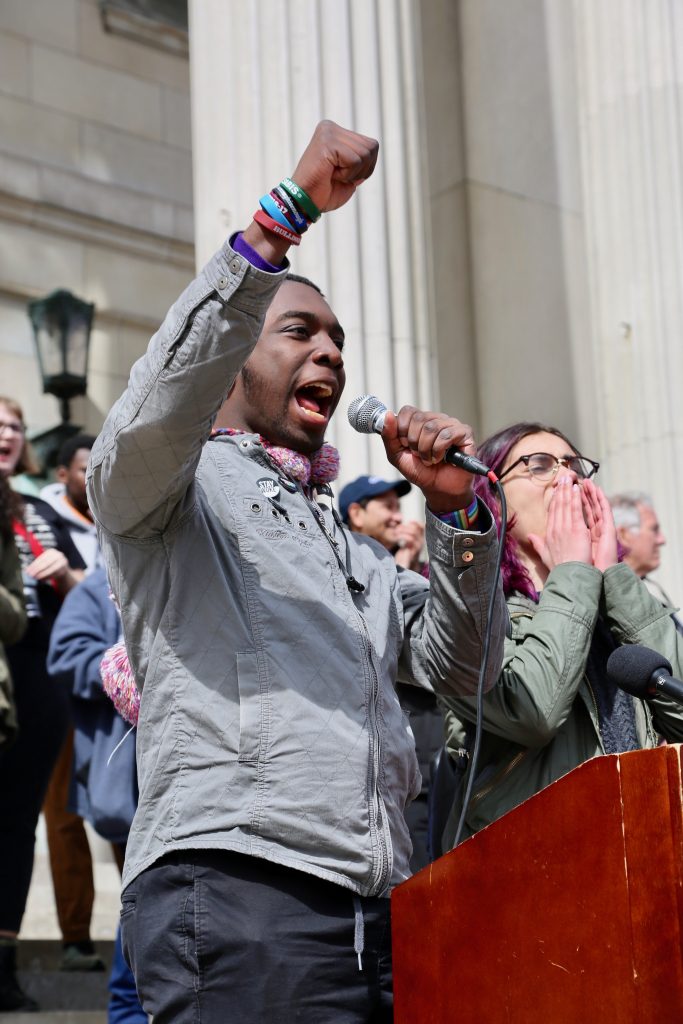In March for Our Lives, Springfield Confronts Its Demons…
SPRINGFIELD—From Court Square past the Central Library to the Federal Courthouse and back, hundreds, perhaps a thousand, marched. A bolero of car horns met them along major arteries. Both victim and source of gun proliferation, Springfield offered a rare show of civic force Saturday, adding its voice to calls for action to stop mass shootings and everyday gun violence.
Echoing Parkland, Florida shooting survivors’ March for Our Lives in Washington, young people nationwide have organized sibling marches. The one in Springfield attracted Senator Elizabeth Warren and Representative Richard Neal and exceeded organizers’ expectations, despite the city’s often politically apathetic populace.
“It’s time for students to stand up,” Sabis International student Trevaughn Smith said. It fell to his generation because politicians had, up to now, been “twiddling their thumbs” over gun violence.
In Washington Marjory Stoneman Douglas High School students and other young people affected by gun violence took center stage. But from Washington to Los Angeles and Springfield the message was the same. Political leaders must stop bowing to the National Rifle Association, an industry lobby posing as a member-advocacy group.
Aerial footage shows the turnout at various March for Our Lives across the US today https://t.co/50KflY3S4X pic.twitter.com/MVxCufnaIQ
— CNN (@CNN) March 24, 2018
To Parkland students’ credit, they have thought beyond their own tragedy and themsleves. Indeed, they have active collaborated with urban peers whose pleas for action, Parkland student frankly admit, have not received the same attention. Similar cooperation played out in Springfield.
“I think this march is an example of how we can get together,” Sarah Reyes, 16, said. Reyes, a Longmeadow High School student, said she has friends and Springfield and they all realize the problem transcends borders.
“We have to address the fact that gun violence is so much more prevalent in cities like Springfield than it is in suburbs,” she continued. “We don’t just want to address gun violence when it happens in a suburb like Parkland.”
In Springfield the issue is especially complicated. While mass shootings are rare, the city does suffer from persistent street, neighborhood and park shootings.
Yet, it is also the home of Smith & Wesson, the gunmaker of the Parkland shooter’s AR-15. That is unique tension came to fore on the steps of City Hall.
“People here are desensitized to these shootings and so are our suburban neighbors and sadly they seem to expect them to happen here,” Hussein Abdi, a Central High School student told the crowd Saturday.
Nonetheless, he urged people not to forget the victims whether in Springfield, Parkland or Agawam is someone’s child or friend. “We need to fight for all these young people,” Abdi said.
Then there is elephant a few miles away on Roosevelt Avenue.
Abdi and others have protested outside Smith & Wesson’s headquarters down the road from Central High. They have demanded a meeting with the company’s CEO to discuss how the company could help keep its products out of dangerous hands. Abdi noted that Smith & Wesson made the weapons used in shootings in Aurora, Colorado and San Bernardino, California.
“Smith & Wesson needs to see us, all of us and known they can’t hide from us,” Abdi said.
In addition to Warren and Neal, Mayor Alex Morse and Councilor Jossie Valentin of Holyoke, Springfield City Councilor Adam Gomez, State Rep Carlos Gonzalez and State Senator James Welch atteneded the march. Tracye Whitfield, a 2017 at-large Council candidate, fired up the crowd just before the march began.
“Right now, you are showing us adults, who don’t come together collectively, how to do it,” she said speaking to the young organizers.
The march’s route passed iconic Springfield landmarks, many of which had borne witness to gunfire or its consequences.
Facing State Street there was Augustus Saint-Gaudens’s The Puritan. Some 15 years before, daylight gunshots rang out in the Quadrangle which the library and museums front. Downtown cathedrals and churches have hosted funerals of shooting victims. Bullets have pierced the calm of many street corners.
After the march returned to the steps of City Hall, Warren stepped up to speak.
“We shouldn’t have to be here today!” she said. “We have known about gun violence for years and for years these hideous killing shave gone on and on and Congress has done nothing.”
But she was sanguine about overcoming the NRA’s influence. Turning to the assembled young people Warren said, “You may not be old enough to vote, but you have power.” Washington, she continued may be serve the top, but this movement will help change that.
“Let’s make change, let’s go out and save some lives!” Warren said.
Speaking next, Congressman Neal, whose career prior to politics had been in teaching high school and college, poured cold water bringing guns to the classroom.

In Center, Sen. Elizabeth Warren, Holyoke Councilor Jossie Valentin, and Rep. Richard Neal look on as students starte the speaking program. (WMassP&I)
“As someone who spent much if his professional life in a classroom, arming teachers is a terrible idea,” he said. Neal then ticked off the major school shootings over the last 20 years and the body counts.
“Let me be specific here about a plan. And tell me one of these issues that I’m about to offer is not entirely reasonable,” he said. Among items Neal listed were background checks, minimum age requirements, mental health checks, and limits on gun sales to domestic abusers and those on the no-fly list. He also feted Massachusetts’s bans on assault rifles and other high-powered weapons.
Springfield School Committee member LaTonia Monroe Naylor dug deeper into the history, noting the first recorded school shooting took place in 1764. “Why hasn’t anybody stopped this?” she demanded.
But the focus remained on the rally’s young organizers, not the pols. The program concluded with a reading of the names of the dead at Stoneman Douglas High.
Smith, the Sabis student who informally emceed the speeches, told the crowd Springfield’s march began with meetings at the 16 Acres branch library.
The first-generation son of Jamaican immigrants, Smith told WMassP&I he has not personally witnessed or heard gunfire. “I was blessed to not have witnessed any gun violence,” he said.
However, his parents did face the threat of gunfire frequently in the old country. “I need to carry on this legacy for my parents and I need to secure gun control in America before it turns into another Jamaica,” Smith, 17, said.
As many have remarked—including this blog—in contrast to other shootings, the Parkland survivors have a lived experience and the capacity to broadcast it. Their age and media savvy has parried cynical attacks while projecting an articulate, enduring message.
Reyes, speaking to the crowd, wove in Supreme Court jurisprudence and the Founding Fathers. Though she disagreed with court decisions on the Constitutional right to firearms, Reyes observed neither the Founders nor the Court expected this would cover the deadliest weapons.
“Gun violence has been an epidemic in this country for far too long,” Reyes said in an interview. The goal, she continued, is to the capture the momentum to change the status quo.
At the same time, these events have profoundly affected these students. Cameron Kasky, a Parkland survivor, told the Washington March the shooting thrust him and his peers into adulthood. Combined with seemingly higher public engagement in the Trump-era, these events could reverberate from the national level right to cities with historically moribund civic participation as in Springfield.
WE WILL WIN. #MarchForOurLives pic.twitter.com/IifZy72lno
— Jackie Corin (@JaclynCorin) March 24, 2018
"Since this movement began, people have asked me, do you think any change is going to come from this?" says Cameron Kasky, a Stoneman Douglas student. "Look around. We are the change." https://t.co/jujbxM0M4i #MarchForOurLives pic.twitter.com/qfKWO2sUZl
— CBS News (@CBSNews) March 24, 2018
“We’re hoping that we can teach students that they do have a constitutional right to protest,” among other rights,” Smith said. “This protest will not only show [change] is possible, but this can show that students do have a voice.”
Maureen Frazier of Longmeadow, holding a sign in Court Square, praised the students’ involvement. She recalled her own activism going back to the Civil Rights era.
“This is a wonderful experience for young people to partake in and to run and to lead,” she told WMassP&I as the march began. “It shows them that together, they can make changes in society.”
The next step will be just as crucial, though.
“I see us continuing to fight. I see us take action and specifically action with Smith & Wesson,” Reyes said. That means keeping the pressure up, not to hound them out of business, but to coax them toward a partnership to reduce gun violence in Springfield and beyond.
All the engagement is ultimately in service to a simpler purpose: saving lives. Ghastly deaths such as those in Parkland or the streets of Springfield are not inevitable, but unavoidable without action.
Following a powerful minutes-long silence, Parkland student Emma Gonzalez summed it up well to the March in Washington.
“Fight for your lives before it’s someone else’s job,” she said.


